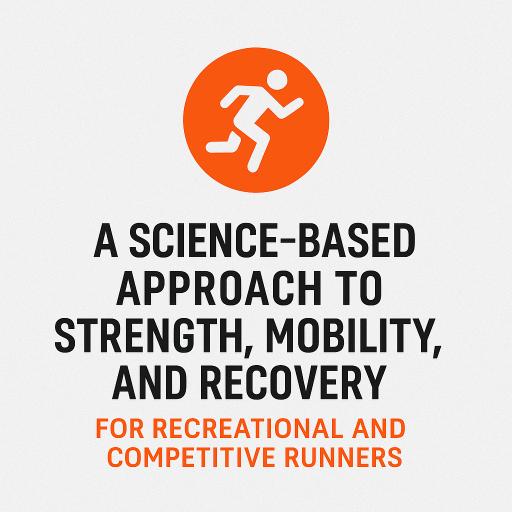Optimizing Physical Conditioning for Runners
A Science-Based Approach to Strength, Mobility, and Recovery for Recreational and Competitive Runners

A Science-Based Approach to Strength, Mobility, and Recovery for Recreational and Competitive Runners
Running performance, injury prevention, strength training, mobility, endurance, overuse injuries, neuromuscular control, periodization
Abstract:
Runners often focus exclusively on cardiovascular endurance, neglecting critical components of fitness such as strength, mobility, and neuromuscular control. This oversight can lead to overuse injuries and performance plateaus. This article explores evidence-based strategies for addressing the special fitness needs of runners, integrating strength and mobility training into traditional running regimens to optimize biomechanical efficiency, enhance injury resilience, and improve overall running performance.
Running is a high-repetition, impact-driven activity that imposes unique demands on the musculoskeletal system. Despite its simplicity, running exposes athletes to significant biomechanical stress, particularly when training volumes are high. Without supplemental conditioning, runners are at increased risk for chronic injuries such as patellofemoral pain syndrome, iliotibial band syndrome, and plantar fasciitis (Van Gent et al., 2007).
Addressing these risks requires a specialized approach that incorporates strength training, mobility work, and structured recovery periods.
Key Fitness Needs for Runners
1. Strength Training for Structural Integrity
Contrary to outdated beliefs, resistance training does not hinder endurance performance; rather, it enhances it by improving running economy and reducing injury risk (Yamamoto et al., 2008). Focus areas should include:
Gluteal Strength: Weak gluteus medius muscles contribute to poor hip stabilization, leading to knee valgus and overpronation (Distefano et al., 2009).
Core Stability: Proper core engagement helps maintain pelvic control during the gait cycle.
Lower Leg Strength: Targeting the tibialis anterior and intrinsic foot muscles supports arch control and reduces plantar fasciitis risk.
2. Mobility and Joint Range of Motion
Limited hip and ankle mobility compromise stride mechanics and increase compensatory movements. Dynamic stretching and mobility circuits focused on the hip flexors, calves, and hamstrings improve movement efficiency (Behm & Chaouachi, 2011).
3. Neuromuscular Control and Balance Training
Proprioceptive training, including single-leg balance work and unstable surface exercises, reinforces joint stability, particularly at the knee and ankle, reducing the likelihood of sprains and repetitive strain injuries (Gribble et al., 2004).
4. Recovery and Periodization
Without proper recovery protocols, including sleep optimization, nutrition support, and active recovery sessions, runners risk overtraining syndrome. Periodized training models incorporating deload weeks and cross-training improve long-term adaptations (Foster et al., 1998).
Conclusion
A well-rounded fitness approach for runners extends beyond mileage accumulation. Incorporating strength, mobility, and neuromuscular training not only mitigates injury risks but also improves performance outcomes. Coaches and athletes should prioritize evidence-based programming to ensure sustainable progression in running efficiency and endurance.
Thank you for reading and/or listening. Voice is AI generated.
Updated: May 13, 2025 17:30
Category: Fitness
Keywords: Running performance injury prevention strength training mobility endurance overuse injuries neuromuscular control periodization
References
Behm, D.G., & Chaouachi, A. (2011). A review of the acute effects of static and dynamic stretching on performance. European Journal of Applied Physiology, 111(11), 2633–2651. https://doi.org/10.1007/s00421-011-1879-2
Distefano, L.J., et al. (2009). Gluteal muscle activation during common therapeutic exercises. Journal of Orthopaedic & Sports Physical Therapy, 39(7), 532-540. https://doi.org/10.2519/jospt.2009.2796
Foster, C., et al. (1998). A new approach to monitoring exercise training. Journal of Strength and Conditioning Research, 12(1), 109-115. https://doi.org/10.1519/00124278-199802000-00019
Gribble, P.A., et al. (2004). Effect of static and dynamic balance training on postural stability in young athletes. Journal of Athletic Training, 39(3), 246-253.
Van Gent, R.N., et al. (2007). Incidence and determinants of lower extremity running injuries in long distance runners: A systematic review. British Journal of Sports Medicine, 41(8), 469-480. https://doi.org/10.1136/bjsm.2006.033548
Yamamoto, L.M., et al. (2008). The effects of resistance training on endurance distance running performance among highly trained runners: A systematic review. Journal of Strength and Conditioning Research, 22(6), 2036–2044. https://doi.org/10.1519/JSC.0b013e318185f0a3
Comments
You must log in to post a comment.